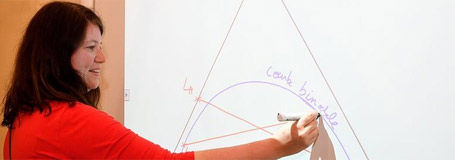Seamanship
Code UE : HBB330
- Cours + travaux pratiques
- 3 crédits
- Volume horaire de référence
(+ ou - 10%) : 30 heures
Responsable(s)
Claire MARION
Objectifs pédagogiques
Module Outline:
1. SHIP CONSTRUCTION
- determine the vessel's main construction components
- recognize the terminology for locations on a vessel
- identify the major equipment systems
- identify different ship types and their major differences
- determine the engines on board
- determine the effect of engines on board (noise, interference)
- explain the purpose of derricks, davits, A-frames, cranes, winches and capstans
2. STABILITY
- basic stability principles
- list factors affecting ship stability and how to react
3. ROPES AND WIRES
- Recognize different types of wire, natural, and synthetic rope
- Tie a square knot, clove hitch, and bowline
- Give examples where each might be used on a boat or aboard ship
- Describe the purpose and use of block and tackle
- Describe methods for securing equipment for heavy weather
1. SHIP CONSTRUCTION
- determine the vessel's main construction components
- recognize the terminology for locations on a vessel
- identify the major equipment systems
- identify different ship types and their major differences
- determine the engines on board
- determine the effect of engines on board (noise, interference)
- explain the purpose of derricks, davits, A-frames, cranes, winches and capstans
2. STABILITY
- basic stability principles
- list factors affecting ship stability and how to react
3. ROPES AND WIRES
- Recognize different types of wire, natural, and synthetic rope
- Tie a square knot, clove hitch, and bowline
- Give examples where each might be used on a boat or aboard ship
- Describe the purpose and use of block and tackle
- Describe methods for securing equipment for heavy weather
Compétences visées
Learning Outcomes:
The aim is to gain basic knowledge about seamanship.
Ability to interprete ship's plans, dangers and tools to perform good seamanship
The student will obtain an idea of the different actions that can cause dangers to the stability of the vessel.
The aim is to gain basic knowledge about seamanship.
Ability to interprete ship's plans, dangers and tools to perform good seamanship
The student will obtain an idea of the different actions that can cause dangers to the stability of the vessel.
Contenu
Lecture 1 Ship construction
Different types of vessels.
Construction of small boat.
Relation between boat size and manoeuvring characteristics.
Watertightness at the propeller shaft
Lecture 2 Ship construction
Characteristics of an outboard engine.
Construction of derricks and frames on the vessel.
Moon pools in vessels.
Vibrations on board vessels
Lecture 3 Stability
Flotation law.
Relation in the position of the centre of gravity and the centre of buoyancy.
Reaction when shifting or adding weights on board a vessel.
Effect of free surfaces
Lecture 4 Stability
Influence on the stability when using cranes and derricks.
Stability curve and angle of Loll.
Lecture 5 Ropes and wires
Different types of ropes and their characteristics
Lecture 6 Ropes and wires
Practice on different knots and splices
Different types of vessels.
Construction of small boat.
Relation between boat size and manoeuvring characteristics.
Watertightness at the propeller shaft
Lecture 2 Ship construction
Characteristics of an outboard engine.
Construction of derricks and frames on the vessel.
Moon pools in vessels.
Vibrations on board vessels
Lecture 3 Stability
Flotation law.
Relation in the position of the centre of gravity and the centre of buoyancy.
Reaction when shifting or adding weights on board a vessel.
Effect of free surfaces
Lecture 4 Stability
Influence on the stability when using cranes and derricks.
Stability curve and angle of Loll.
Lecture 5 Ropes and wires
Different types of ropes and their characteristics
Lecture 6 Ropes and wires
Practice on different knots and splices
Modalité d'évaluation
- Contrôle continu
- Projet(s)
- Examen final
Cette UE apparaît dans les diplômes et certificats suivants
Rechercher une formation
RECHERCHE MULTI-CRITERES
-
Vous pouvez sélectionner des formations grâce à un mot ou à une expression présent dans l’intitulé ou dans les index (discipline ou métier visé).
Des index vous sont suggérés à partir du 3e caractère saisi, mais vous pouvez aussi saisir librement tout autre mot . - Les différents items sélectionnés sont croisés.
ex: "Comptabilité" et "Région Grand Est" - Validez par le bouton « Rechercher » ou par la touche Entrée.
- Cette recherche affiche aussi les fiches UE et certificats régionales. Leurs codes les distinguent des fiches nationales par le suffixe de la région (ex : « -IDF » ).
Par défaut, les fiches régionales reprennent le contenu de la fiche nationale correspondante. Mais dans certains cas, des informations régionales ont pu être ajoutées. - Certains diplômes se déclinent selon plusieurs parcours. Pour afficher tous les parcours, tapez la racine du code (ex : « LG035 »).
- Certains stages ont un double code : leur code propre et le code de l’UE ou du certificat équivalent.
- Dans tous les cas, veillez à ne pas insérer d'espace ni de ponctuation supplémentaire.
- Validez par le bouton « OK » (et non pas par la touche Entrée).
Chargement du résultat...

Intitulé de la formation |
Type |
Modalité(s) |
Lieu(x) |
|
|---|---|---|---|---|
Intitulé de la formation
Bachelor océanographe prospecteur
|
Lieu(x)
Initial
|
Lieu(x)
Paris
|
||
| Intitulé de la formation | Type | Modalité(s) | Lieu(x) |
Contact
Voir le calendrier, le tarif, les conditions d'accessibilité et les modalités d'inscription dans le(s) centre(s) d'enseignement qui propose(nt) cette formation.
Enseignement non encore programmé
Code UE : HBB330
- Cours + travaux pratiques
- 3 crédits
- Volume horaire de référence
(+ ou - 10%) : 30 heures
Responsable(s)
Claire MARION

















